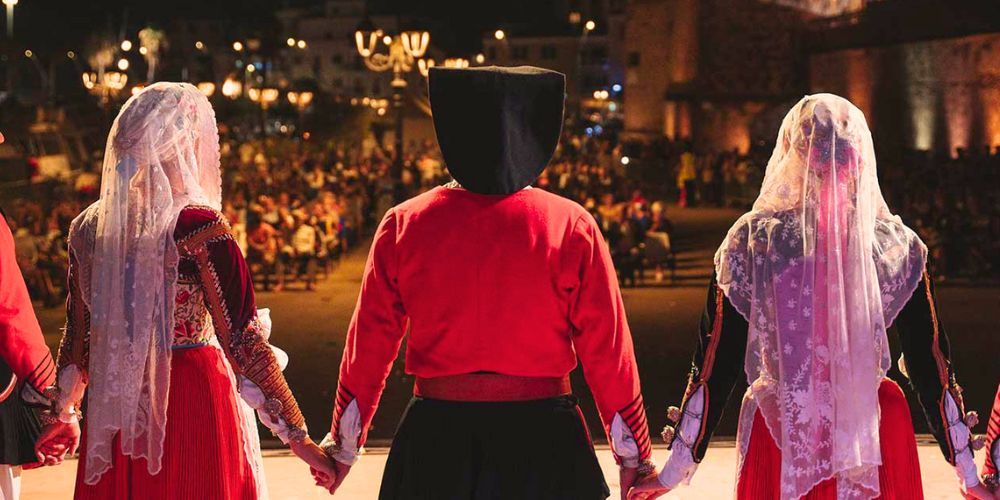Visiting new destinations is never just a mere matter of moving from one place to another, but first of all an adventure made of expectations and emotions, to experience through mind and heart. Destinations like Sardinia, a magical land with a thousand-year history, an enchanting island with one of the most complex and fascinating cultural landscapes in the world, result of a melting pot that tells the very essence of the Mediterranean. And which finds its best expression in the celebration of spectacular religious rituals, crossroads of sacred and profane.
With a vast calendar of festivities and holidays of great cultural relevance, like the events part of the program Salude & Trigu, each moment of the year is a unique opportunity for an extraordinary journey to discover this island rich in mysteries and faith. Moments of pure magic, where to witness first-hand the most impressive religious rituals in Sardinia and collect precious memories of a trip that never ends, for real, once you return home.
If you want to experiment such fantastic sensations too, let’s find out the most evocative events and experiences to enjoy the best religious rituals in Sardinia between faith and folk culture.

Impressive religious rituals in Sardinia: a journey of spiritual and mystical identity
Whether it’s the solemn celebrations for the Holy Week waiting for Sa Pasca Manna, or Easter, the fascinating yet disturbing masks and customs of Carnival, among the most important celebrations on the island, or the ancient rites of Is Animeddas and Su Mortu Mortu, known as the Festival of Souls or simply as Sardinian Halloween, a trip to Sardinia becomes an even more mystical and exciting experience when there’s the opportunity to explore deep in the heart of its culture and check out by your own the wonders of the most spectacular religious rituals of the local folk tradition.
A journey that gives unique emotions, from north to south across whole Sardinia, from its largest cities to the most mysterious villages in the hinterland, a real adventure to discover the most authentic and profound spiritual identity of this land and its people.
It’s time to finally make room for the costumes, the masks, the atmospheres and the unparalleled sensations of the most iconic religious rituals in Sardinia. Which one will inspire you the most?
5. The Holy Week in Sardinia, religious rituals and folklore across the island
The religious rituals of the Holy Week in Sardinia are some of the most impressive, ancient and consolidated in the Italian landscape, with a rich tradition that boasts centuries of history and has its roots in the Middle Ages. Many typical customs of Sa Pasca Manna and Setmana Santa are indeed the result of the strong Spanish influence throughout Sardinia, especially in the north and along the western coast, in a unique and fascinating mix of Hispanic culture, faith’s myths and local folklore.
Everyday in Easter week is characterized by fascinating and mystical events, which transform the most picturesque locations in Sardinia into places with an even more magical aura. Moments such as the solemn pilgrimage of Lunissanti in Castelsardo, on Holy Monday, or the evocative and surreal procession of Mysteries in Iglesias on Holy Tuesday accompanied by the ghostly figures of Baballottis, hooded penitents completely dressed in white. Without forgetting about the Wednesday, dedicated to the preparation of Sos Sepurcros at the churches in every town and village, and the iconic Cerques - or searches - the processions of devotees to visit and venerate the holy sepulchres, often led by local brotherhoods with the simulacrum of the Virgin Mary.
Between Good Friday and Easter Sunday, it’s time to celebrate the most important and significant religious rituals of these festivities, widespread throughout Sardinia and part of the cultural heritage inherited from the Spanish. We’re talking about Ilcravamentu, or also S'Iscravamentu, the ritual that depicts the holy deposition of Christ from the Cross after his death - a key event especially for the celebrations in Alghero, where it’s known as Desclavament and includes a real funeral rite too - and S'Incontru, a traditional procession that follows the Easter Mass and consists of the joyful meeting of the simulacra of Risen Jesus and Holy Mary. All this, enclosed in the splendid landscape settings of the most beautiful locations in Sardinia!
4. The March of Candelieri in Sassari
Speaking of religious rituals in Sardinia, it’s impossible to ignore an event so rich in emotion, charm and culture as the Faradda or March of Candelieri in Sassari, which has been part of the Unesco intangible heritage since 2013 and today represents one of the most important and picturesque examples of the Italian tradition of Great Shoulder Machines.
The celebration, which takes place in the heart of Sassari every year on August 14 in honor of the Assumption of Holy Mary, now has about five centuries of history behind it and represents an act of great faith and devotion. Its ancient origins can indeed be traced back to the late Middle Ages, probably also part of the cultural heritage inherited from the Spanish, but it was only in the 17th century that the festival took on its actual features commemorating a vow made to the Virgin to protect the city from an epidemic of plague.
The March of Candelieri, an event that attracts thousands of devotees and enthusiasts from all over Sardinia (and beyond), is a real dancing procession that involves the members of the ancient corporations of workers of the city of Sassari, or Gremi, engaged in carrying on their shoulders the Candelieri, that are symbolic candles in the form of large, richly decorated wooden columns. The route of this picturesque procession has remained unchanged over the centuries, touching some of the most iconic places in the city such as Piazza Castello, Piazza Azuni, Largo Cavallotti, Corso Vittorio Emanuele II, Porta Sant'Antonio, Corso Francesco Vico, and the Church of Santa Maria di Betlem near Porta Utzeri.
The Faradda is undoubtedly among the most spectacular Sardinian religious rituals and is comparable, in terms of emotions, aesthetics and technical characteristics, to other prominent Italian traditions such as the Macchina di Santa Rosa in Viterbo and Festa dei Gigli in Nola.
3. The Fire Rituals of Sant’Antonio Abate in Mamoiada
In Sardinia Carnival is a serious matter, a true container of traditions, culture and experiences halfway between the mysticism of faith and the popular folklore. Experiences like the magical religious Fire Rituals of Sant’Antonio, an ancestral fascinating celebration that takes place every year on the night between January 16 and 17 all over the island.
The celebration of Sant’Antoni ‘e su Fogu consists of lighting large bonfires near the churches dedicated to the saint, acknowledged as the guardian of fire and its vital power. A religious ritual that, more than any other in Sardinia, is capable of exploring deeply into the pagan roots of the region bringing them back on top under a different, secular spotlight. The Fire Rituals of Sant’Antonio have indeed always been considered a propitiatory rite for the whole community, a moment of definitive overcoming of the old year, of purification through the flames and of welcoming towards the new, with a wish for abundance, fertility and wealth.
Particularly famous and important is the fire ritual in Mamoiada, known by everybody as the City of Sardinian Carnival, an event that officially marks the beginning of the time of Su Carrasegare with the appearance of the great protagonists of this festival, the mysterious, disturbing, yet terribly fascinating masks of Mamuthones and Issohadores, respectively symbols of the sometimes brutal force of nature and of human discipline in knowing how to tame and control it.
Witnessing this magical event is a truly unique experience, a journey through time that reveals the most authentic and mysterious soul of Sardinia, enclosed in the heart of its traditions and its religious rituals, warming the winter cold with the purity of fire in such an evocative metaphor of the cyclical nature of life.
2. The Ardia of San Costantino in Sedilo
Imagine a wild and adrenaline-filled horse ride, full of devotion, colors and pathos, that crosses the entire town of Sedilo in an explosion of lively folk passion. This is the Ardia of San Costantino, a truly unique one of a kind event and certainly one of the most picturesque religious rituals in all of Sardinia.
This reckless horse race, an event that is part of the rich tradition of Sardinian equestrian games, the iconic Sa Pariglia, takes place every year on July 6 and 7 to commemorate the historic victory of the Roman emperor Constantine (in some cultures venerated as a saint, locally Santu Antinu in Sardinia, who also made history for being the one who liberalized Christian worship in the territories of the empire) in the battle of Ponte Milvio against his rival Maxentius, the latter self-proclaimed true emperor.
The Ardia, which literally means to protect and guard, is not just a simple horseback folk competition, but an act of faith in homage to San Costantino that involves hundreds of riders in traditional costumes, a true "unbridled procession" that thrills the entire village - as well as some nearby locations, such as Pozzomaggiore and Giave, where horseback religious rituals are celebrated in honor of other saints too - in a festival that goes beyond faith and history, becoming a symbol of fun, cultural belonging and enhancement of traditions.
1. The Festival of Sant’Efisio in Cagliari
When it comes to the south Sardinia, finally, there’s one of the most heartfelt and important religious and folkloric rituals of the whole island, a celebration that unites the Sardinian people in a mosaic of colors, scents, emotions and customs, without distinctions of provinces and territories. It’s the Festival of Sant'Efisio, martyr of Christianity venerated especially in the area of Cagliari, recognized as one of the patrons of the island given his important evangelization mission of Sardinians back when paganism was still widespread.
The Festival of Sant'Efisio in Cagliari takes place every year between May 1 and 4, for many representing a "second Easter" and a true celebration of springtime and its meaning of rebirth and new abundance. The religious rituals that distinguish this event are indeed a perfect mix between sacred and profane, between divine and secular, just like all the pop culture of this magical island.
The religious aspect of the celebration is mainly based on the long pilgrimage of the simulacrum of Sant’Efisio, from his church in the heart of Cagliari to the place of his martyrdom, the ancient town of Nora now part of the territory of Pula, an event that gathers thousands of devotees from all over Sardinia.
In honor of the saint, faith’s mysticism also perfectly meets impressive and fascinating customs of folk culture. Among these, the procession of Traccas certainly stands out, the iconic farm carts finely decorated and pulled by oxen through the main streets of the city, and the beautiful flower rituals of Sa Ramadura, a procession of people dressed in traditional costumes characterized by the throwing of millions of wonderful rose petals.
About the author
Written on 03/04/2025



Massimiliano Antonio Primi
Let’s discover together the most spectacular religious rituals in Sardinia, magical experiences to best enjoy your trip to this enchanting island.